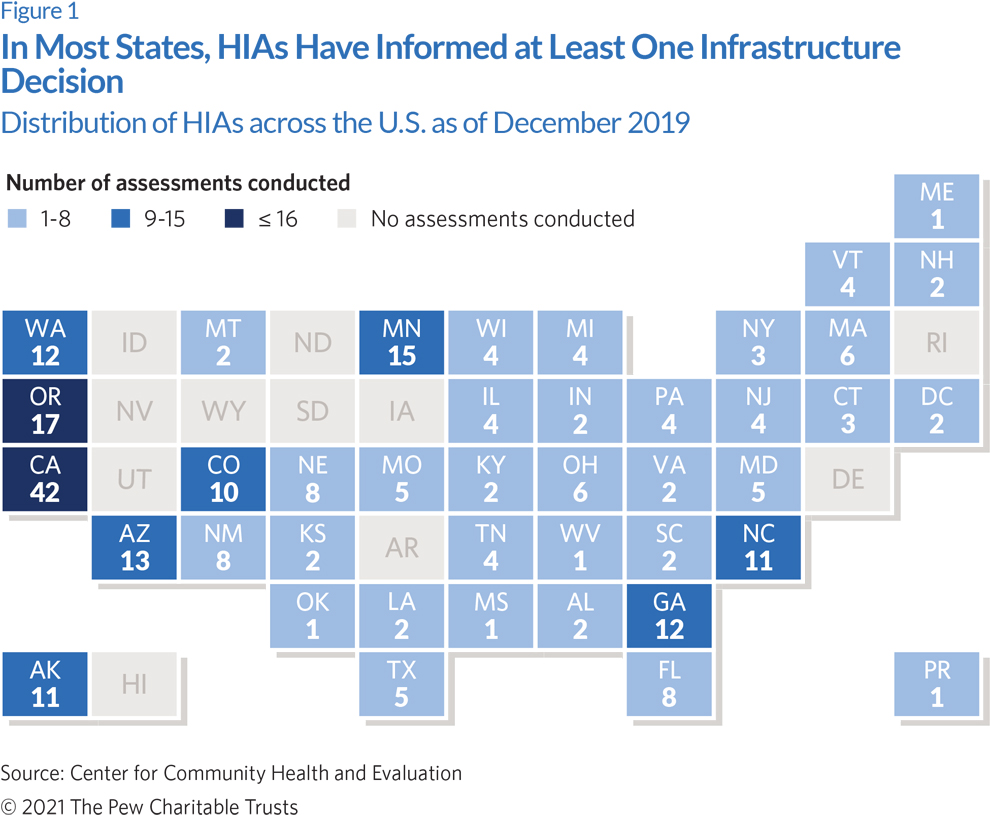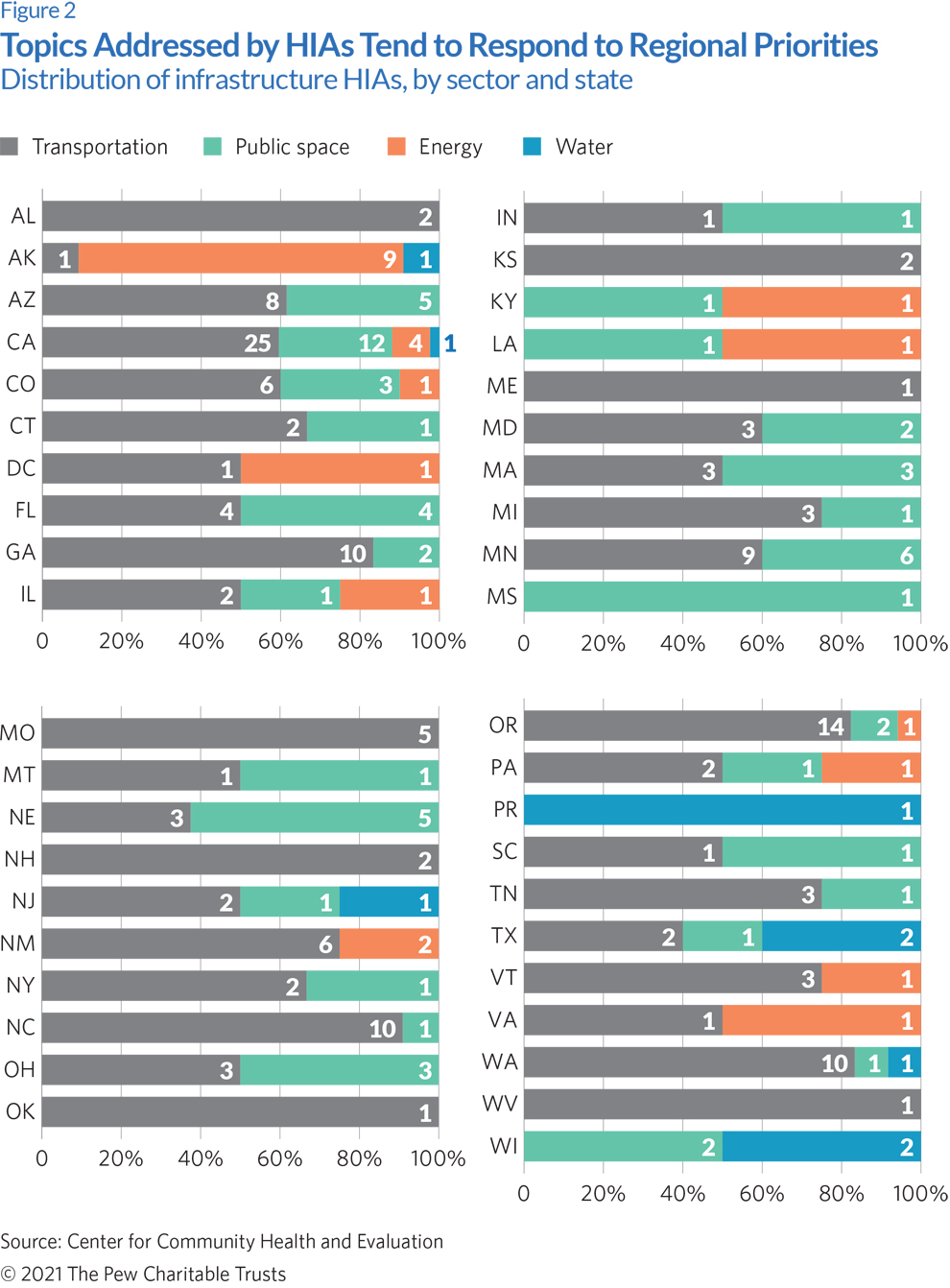Health Impact Assessments, Community Engagement Can Promote Equitable Infrastructure Choices
Strategies to encourage the consideration of health and improve outcomes

Editor's note: This page was updated on May 13, 2021, to reflect a corrected data point for the state of Kansas in Figure 2. The study included two health impact assessments conducted in Kansas, not one.
Overview
Research shows that the design, construction, and operation of public infrastructure—facilities, systems, and structures owned and operated by taxpayers, typically via the government, that are for public use—can affect people’s health. For example, broadly accessible green spaces can boost physical and mental health and encourage physical activity in a community, while poorly constructed water and sewer systems can lead to contamination and expose people to pollutants and other harmful substances.1
However, policymakers, community members, and other stakeholders can take steps to determine the possible health implications of proposed infrastructure projects, including those with the potential to enhance people’s standard of living, such as bridges and airports, parks and gardens, water and sewer systems, power grids, and broadband internet—and to inform planning and decision-making in ways that mitigate potential risks and promote better outcomes.2 Over the past decade, decision-makers have increasingly used health impact assessments (HIAs) to identify whether and how infrastructure programs, policies, plans, or projects could affect health and to illuminate whether certain racial, income, geographic, or other groups are likely to be disproportionally affected.3 Those findings, in turn, can provide a roadmap for advancing health equity—the guiding principle that disparities in health outcomes caused by factors such as race, income, or geography should be addressed and prevented, providing opportunities for all people to be as healthy as possible.
In 2019, the Health Impact Project, a collaboration of the Robert Wood Johnson Foundation (RWJF) and The Pew Charitable Trusts, partnered with the Center for Community Health and Evaluation (CCHE) to explore how the HIA process, resulting findings, and recommendations can inform and improve U.S. infrastructure projects and advance health equity. The study examined the approaches and outcomes of a nonrepresentative sample of 246 HIAs and seven other initiatives, grounded in HIA principles, that were conducted between 2004 and 2019, and focused on decisions related to five sectors: transportation, public space, water, energy, and broadband internet.
The research revealed that:
- HIAs sometimes led to changes to organizations’ decision-making processes and outcomes, including the development of routine ways to examine health data, prioritize health in decision-making, implement beneficial features into final projects, and engage formerly excluded populations, such as low-income communities and those of color.
- When HIAs emphasized community engagement, equity was more prominent in the process, final report, and recommendations. For example, HIA reports were more likely to include information from the community that illuminated disproportionate health impacts or explain how policies drive structural inequities in community well-being when residents were directly involved in the HIA process, such as through data collection or participation in steering committee meetings.
- Assessments that elevated community perspectives on health may offer a long-term view of potential health effects of infrastructure decisions that are often overlooked by outside experts.
Importantly, because HIAs occur in complex political and social environments, each HIA is unique to its decision-making context. And because the sample was small, nonrepresentative, and did not include a comparison group of decisions made without HIAs, these findings cannot be generalized to all HIAs or used to draw definitive conclusions about HIAs’ effects. Rather, they are intended to provide a description of infrastructure HIA contexts to date, identify promising practices, and point out gaps and opportunities for HIAs to help advance health equity through infrastructure decision-making.
Despite these constraints, the findings enabled the Health Impact Project and CCHE to identify four key actions that decision-makers and HIA practitioners and funders can take to strengthen the use of HIAs in infrastructure decisions:
- Prioritize HIAs that assess significant infrastructure issues of relevance to diverse jurisdictions to generate findings with broad applicability and reach.
- Identify ways to systemically integrate health and equity into infrastructure decision-making.
- Support the use of HIAs through funding, capacity building, and messaging.
- Make resources available to enable practitioners and decision-makers to assess and monitor HIAs’ impact and the implementation of recommendations.
What Is a Health Impact Assessment?
An HIA is a process that can help evaluate how proposed policies, programs, and projects could affect the health and well-being of a community. HIAs are typically led by a team that includes representatives of government agencies, educational institutions, and nonprofit or for-profit organizations, and funded through a range of sources, including philanthropic and public agency funding. Their data may include qualitative and quantitative analyses and input from stakeholders to determine how a proposal could affect environmental, social, and economic factors that shape health, and how those impacts are likely to be distributed among the population. HIAs also provide pragmatic, evidence-based recommendations to reduce risks, promote benefits, and monitor health effects after a decision is implemented.
HIAs involve six steps; engagement with the communities and individuals that may be affected, policymakers, and other stakeholders occurs throughout the steps.
- Step 1: Screening. The HIA team and stakeholders determine whether an HIA is needed, can be accomplished in a timely manner, and would add value to the decision-making process.
- Step 2: Scoping. The HIA team and stakeholders identify the potential health effects that will be considered and develop a plan for completing the assessment, including specifying their respective roles and responsibilities.
- Step 3: Assessment. The HIA team evaluates the proposed project, program, policy, or plan and identifies its most likely health effects using a range of data sources, analytic methods, and stakeholder input to answer the research questions developed during scoping.
- Step 4: Recommendations. The team and stakeholders develop practical solutions that can be implemented within the political, economic, or technical limitations of the project or policy to minimize identified health risks and maximize potential health benefits.
- Step 5: Reporting. The team disseminates information, including the HIA’s purpose, process, findings, and recommendations to a wide range of stakeholders.
- Step 6: Monitoring and evaluation. The team and stakeholders evaluate the HIA according to accepted standards of practice. They also propose a plan for monitoring and measuring the HIA’s impact on decision-making and the effects of the implemented decision on health.
Methodology
The research summarized information from 246 HIAs and seven other initiatives, grounded in HIA principles, conducted between January 2004 and October 2019.4 CCHE identified the sample from the Health Impact Project’s Cross-Sector Toolkit for Health, which offers a collection of HIAs, guides, and other research to support policymakers’ efforts to consider health when making decisions. For each of the 253 items in the sample, CCHE gathered and analyzed descriptive information including the location, topic(s) examined, and lead organization, and then selected a subset of 51 HIAs that were either completed in the five years before this research or for which detailed data existed from prior studies. From those 51, CCHE highlighted four case studies—one from each sector of interest: transportation, public space, water, and energy, except broadband for which no HIAs were found—to showcase HIAs’ impact on community engagement, equity, decision-making, and infrastructure changes.
CCHE also interviewed three experts in conducting infrastructure-related HIAs to examine how the findings could inform efforts to advance health and equity within the examined sectors and reviewed all the data and findings to identify opportunities for using HIAs and to advance health equity.
The researchers’ evaluation of the sample, case studies, and expert interview responses was guided by the following questions:
- What decision-making entities and types of decisions did these HIAs and similar initiatives seek to inform?
- To what extent and through what methods did HIA practitioners engage community stakeholders in infrastructure HIAs and similar initiatives?
- To what extent and through what methods did HIA practitioners examine the equity implications of infrastructure decisions through HIAs and similar initiatives?
- What messaging about equity did HIA practitioners use with decision-makers (e.g., in reports or other communication materials)?
- To what extent have infrastructure HIAs and similar initiatives changed decision-makers’ understanding of the connections between infrastructure, health, and equity, and whether/how they consider these connections in future policymaking?
- To what extent have infrastructure HIAs and similar initiatives resulted in changes to the final decision and/or informed the design and implementation of the decision?
- Are there examples of when community engagement in an infrastructure HIA or similar initiative led to community engagement in a subsequent project or decision?
Impacts of HIAs on infrastructure decisions
If designed and constructed with human health in mind, public infrastructure can help maximize wellness and mitigate potential risks. However, infrastructure planning and construction that does not consider health implications can lead to or exacerbate poor outcomes. And research shows that communities of color and low-income communities unfairly bear health burdens associated with poorly designed and maintained infrastructure, and that these disparities are shaped by historical policies.5
For example, one report found that low-income people and minorities are more likely than non-Hispanic White people and those from middle- or high-income households to live near coal power plants, which can emit sulfur dioxide, nitrogen oxides, particulate matter, and mercury, compromising air quality and increasing rates of asthma and other respiratory illnesses.6 Additionally, people of color are more likely than non-Hispanic Whites to live in areas with significant and persistent water contamination and frequent stormwater and wastewater overflows. Research also has shown that a higher percentage of Indigenous people, compared with the U.S. population broadly, live in homes without access to a safe water supply and wastewater services; as of 2012, nearly 12 percent of Americans living on reservations and 30 percent of Indigenous Alaskans lacked plumbing.7
Although an environmental impact assessment process is required by law for many infrastructure projects, those reviews typically include only a cursory review of potential health impacts.8 Increasingly, however, community members, decision-makers, and other stakeholders are conducting HIAs on infrastructure proposals to better understand and respond to the possible health and health equity implications of design, construction, maintenance, and other planning.
This research suggests that HIAs can shine a light on the unintended consequences of and underlying inequities in infrastructure decisions, policies, and projects, offering decision-makers the opportunity to mitigate those problems with actions such as changing exclusionary processes and other historically inequitable structures.
What do HIAs contribute to infrastructure decisions?
This analysis found that HIAs may add value for decision-makers by providing critical context and perspective to inform planning processes and that they supplement the cursory analysis of health impacts typically included in environmental impact assessments in four key ways.
Raise awareness of health and equity issues
The research revealed that HIAs can educate engineers, planners, and public agency officials about community health issues and empower public health professionals to share their expertise and translate data and technical concepts into digestible information for all stakeholders, which, in turn, enables community members to more easily offer perspectives on key questions during decision-making conversations. For example, an HIA in Atlanta that focused on a green infrastructure project raised policymakers’ awareness about the connections between health and the built environment, which contributed to the city’s dedicating an additional $1.2 million toward enhancing the project.
Elevate community perspectives to generate solutions with broad support
Because they routinely include interviews, focus groups, surveys, and workshops with community members, HIAs can bring community perspectives on projects’ potential health impacts to the decision-making process and promote cooperative problem-solving among community members and decision-makers. This engagement can increase the likelihood that HIA recommendations will be supported and implemented in those communities. Further, the findings suggest that, when led by community organizations and residents, HIAs are more likely to attract media attention to the proposed decision, which, in turn, can spur public officials to acknowledge the importance of health and health equity.
In Smoketown, a majority Black neighborhood in Louisville, Kentucky, for example, Project HEAL (Health.Equity.Art.Learning) adapted and applied HIA principles to increase civic engagement through arts and culture and to expand residents’ role in local infrastructure decision-making. In one instance, a coalition of artists created a policy initiative to replace billboards advertising alcohol and tobacco products with locally relevant poetry and images created by community members.9 Alcohol and tobacco marketing is more prevalent in predominantly low-income and Black neighborhoods compared with higher-income and mostly White communities, and can contribute to negative health outcomes, including psychological stress and increased smoking and drinking.10
The coalition’s effort received broad support from the local health department and prompted the department to exhibit additional health messaging for the city’s diabetes prevention program, and resulted in stronger civic engagement and a deeper understanding of health implications in infrastructure. The Smoketown coalition followed that success with other civic engagement campaigns, including writing letters and attending public meetings to influence the Louisville Metropolitan Sewer District’s new 16.7 million-gallon overflow basin plan. And because of that advocacy effort, the basin was ultimately sited underground with a grassy park built on top, rather than above ground as originally planned.
Provide a broad long-term view of potential health effects
HIAs often look 10 to 30 years into the future to predict the eventual or enduring community health and health equity consequences of decisions. By highlighting these effects, HIAs may help policymakers identify near-term actions that can avert longer-term health effects, such as chronic disease, which have significant implications for health care costs and economic productivity.
An HIA is often the first analysis to highlight connections between infrastructure and possible long-term health impacts, such as the connection between neighborhood gentrification and a Superfund cleanup near Seattle that was illuminated by the Lower Duwamish Waterway Superfund Site HIA.11 A team of practitioners from the University of Washington, Just Health Action, and the Duwamish River Cleanup Coalition/Technical Advisory Group conducted an HIA of the proposed Duwamish River cleanup plan to examine the potential effects on the health and well-being of community residents, including three tribes, people who depend on fish from the river for food, and workers in local industries. The HIA recommended that the jurisdiction form a coalition of agencies and community organizations to monitor and guide development at the site to prevent residents from being displaced by gentrification.
Generate systems and processes to routinely consider health and equity
Although each HIA typically addresses just one decision point, it often results in a greater appreciation for health and equity across that sector and can drive interest in forming cross-sector coalitions to help ensure that consideration of health and equity is built into future planning decisions.
In Delaware County, Ohio, the local health district conducted an HIA to inform the development of an outlet mall and, as part of the process, residents formed an advisory group to work with the developer. The HIA effort underscored for decision-makers and resident-advisers both the health effects of infrastructure design and the value of community buy-in, and it led the developer to include many more improvements than the zoning laws required. Over the longer term, the HIA spurred local leaders to solicit the advisory group’s input on the design of a new park and to pass a resolution creating a committee to provide guidance on improving the county’s hiking and biking trails. Members of the advisory group later rose to leadership positions within local government to bring their knowledge on health and equity deeper into local decision-making.
Key HIA features that influence infrastructure decision-makers
The research found that HIAs have the potential to change minds and resulting action, especially when they:
- Are part of or a complement to other efforts, such as existing community organizing campaigns and environmental impact or other assessments. This can help integrate HIAs into the process of launching an infrastructure project.
- Are requested and led by community members, such that they account for varying and disproportionate impacts on different communities and that residents and local organizations are invested in the process and more likely to pursue results. This provision is particularly critical for large-scale infrastructure decisions because those projects often have far-reaching and diverse effects on a community and can affect a range of health outcomes. Practitioners conducting HIAs often do not have dedicated resources to follow up to ensure that recommendations are followed, but, when highly motivated, local residents can help overcome that barrier to HIA value by continuing to work with decision-makers to support implementation of the recommendations. Community-driven HIAs may be more powerful, particularly in instances where the infrastructure investment is controversial, data on potential health impacts is lacking, or certain populations are at risk of disproportionate effects from a decision.
While participating in an HIA to inform the expansion of St. Paul, Minnesota’s light rail system, a community steering committee (CSC) identified affordable housing as a local priority. So, when the city subsequently released a rezoning proposal that did not include an explicit affordable housing policy, the CSC presented recommendations and encouraged decision-makers to address housing issues. Those efforts led city councilmembers to pass a resolution creating an affordable housing working group and to generate policy guidance to ensure that healthy and equitable housing was part of the transportation-oriented development.
- Employ effective communications to disseminate recommendations. For most HIAs, including those related to infrastructure, practitioners may need to translate technical health and health equity concepts to reflect the geographic context and values of the community. Quantitative data combined with local stories, such as residents’ toxin exposure or limited transportation options, can be persuasive with decision-makers.
A snapshot of infrastructure HIAs in the U.S.
The HIAs and initiatives evaluated for this study represent 39 states, the District of Columbia, and Puerto Rico, with 17% (42) of them from California. (See Figures 1 and 2.)
Nearly two-thirds (61%) of these assessments focused on transportation decisions, about a quarter examined public space (26%), and the remainder looked at energy (9%) and water (4%) decisions. The research did not identify any HIAs conducted on broadband decisions, which is not surprising given that access to high-speed internet connections only recently emerged as a significant public health concern, driven primarily by the COVID-19 pandemic.
In each sector, HIAs assessed the health and equity implications of a range of infrastructure decisions, from permitting of a proposed utility-scale solar project to extension of a water system near the U.S.-Mexico border. (See Table 1.)
Table 1
Infrastructure HIAs Informed a Variety of Decisions, Ranging From Site Selection to Extension of Services
Types of choices informed by HIAs in each sector studied
| Sector | Examples of decisions informed by HIAs |
|---|---|
| Energy |
|
| Public space |
|
| Transportation |
|
| Water |
|
Source: Center for Community Health and Evaluation
© 2021 The Pew Charitable Trusts
The majority of the HIAs (58%) in the sample were led by a government agency. Among those, approximately three-quarters of transportation and public space HIAs were conducted by local or state health agencies, while state or federal entities, such as the U.S. Forest Service or the U.S. EPA conducted most energy and water HIAs (75% and 66%, respectively). Similarly, most HIAs in the sample that focused on the energy sector informed state or federal decisions, and the bulk of those in the transportation, public space, and water sectors mostly informed local decisions, all of which is in keeping with the levels of government that make the majority of decisions in these sectors.
Opportunities for advancing health and equity in infrastructure decisions
Based on the findings and input from experts, the Health Impact Project identified four actions that decision-makers, HIA practitioners, and funders can take to increase and strengthen the use of HIAs in in the infrastructure sector.
Prioritize HIAs that assess significant infrastructure issues that are relevant to multiple jurisdictions to generate findings with broad applicability and reach
HIAs on topics of wide concern in key infrastructure sectors, such as those below, will produce recommendations that could be used to inform similar decisions throughout the country.
- Public space. Emphasize assessments for decisions about where to locate public spaces or illuminate potential health benefits of proposed public spaces, for instance, health-related benefits of spaces that encourage community-building, such as community gardens and outdoor plazas, or that provide places of refuge during extreme heat and natural disasters.
- Transportation. Concentrate transportation HIAs on investment decision-making, scoring systems for selecting and prioritizing specific projects, long-range transit planning, and implementation of “value capture” strategies—public financing tools that generate revenue for infrastructure improvements, operations, and maintenance. Prioritizing HIAs on projects of a certain size (e.g., long-range transit plans) may provide additional value and make efficient use of limited HIA resources because such decisions typically have significant potential long-term health and other local impacts, affect a large number of people, and involve substantial, long-term investments.
- Energy. Prioritize decisions about state integrated resource plans, energy efficiency, renewable energy workforce development strategies, and affordable financing models for energy efficiency upgrades.
- Water. Focus on state-level decisions about income-based rate systems and rate assistance programs that help low-income households pay for water services, regulations guiding public and private utility rates, municipal water plans, and decisions about water system consolidation.
- Broadband. Although the researchers did not identify any HIAs focused on broadband decision-making, high-speed internet connectivity has become indispensable to the way people access goods and services, including health care and education. Key broadband topics for far-reaching HIAs might include decisions about incentive programs to encourage private networks to enhance access in under-resourced communities and affordability standards for wireline and wireless subscriptions.
Systemically incorporate health and equity into infrastructure decision-making
- Integrate HIAs with EIAs. Environmental impact assessments may evaluate only immediate human health outcomes related to infrastructure decisions, but HIAs can highlight short- and long-term health impacts, such as the combined effects of local emissions and climate change.
- Provide incentives for the use of HIAs in infrastructure decisions. Sector-specific nonprofits or state and federal government agencies should consider developing, in collaboration with industry partners, an incentive-based system, perhaps modeled on the U.S. Green Building Council’s Leadership in Energy and Environmental Design (LEED) program, to promote HIAs for infrastructure projects. LEED encourages builders to embrace environmentally sound practices by awarding globally recognized green building certification for qualified projects, and a comparable HIA incentive program could promote positive health and equity outcomes and related economic benefits.12 Such a program could accelerate competition-driven systemic adoption of HIAs in infrastructure decisions, within and across subsectors. National, sector-focused organizations could help investors who fund infrastructure projects evaluate potential investments from a health and equity lens.
Support the use of HIAs through funding, capacity building, and messaging
- Expand targeted geographic investments. Although some communities have structures and processes in place that provide opportunities for stakeholder engagement in decision-making, many do not, and HIA funders could invest in places that lack these important structures.
- Improve infrastructure-focused organizations’ capacity—primarily knowledge, resources, and skills—to apply HIAs to pressing topics. For example, through targeted grant opportunities, strategic partnerships, and training and technical assistance, HIA funders and partners could promote the use of HIAs on broadband infrastructure decisions.
- Effectively communicate the role and value of HIAs. By relaying the purpose, process, and benefits of HIAs to stakeholders who are unfamiliar with them, practitioners and funders can build trust and lay the groundwork for uptake.
Support follow-up to assess and monitor HIA impact and implementation of recommendations
- HIA practitioners are not always tasked with promoting their recommendations post-evaluation, but foundations and other funders should consider supporting such follow-up. Local agencies and public officials may not be able to encourage the implementation of HIA recommendations for political, practical, or legal reasons, so turning over HIA results to advocacy groups that can advance the recommendations more forcefully may yield longer-term impact.
Conclusion
Choices made during development of infrastructure projects and policies can significantly benefit or harm community health and health equity. HIAs can help ensure that the potential consequences are thoroughly considered during planning. The HIA process can increase stakeholder understanding of the role of health and equity in infrastructure, promote systemic change, and ensure that people who will be affected by a decision are included in making it.
However, HIAs could be even more effective if they were used more frequently and to address urgent, specific issues; recommended systematic approaches to solving a health or health equity problem; were strategically applied; had broad community support; and were followed up by research and evaluation to determine their impact. Future research could examine the unique contributions of HIAs to infrastructure decision-making by comparing the outcomes of decisions for which assessments were and were not conducted.
The lessons from this research show that decision-makers, funders, and organizations behind infrastructure projects should work together to make decisions and investments that promote equity, reduce disparities, and foster healthy, thriving, and sustainable communities.
Endnotes
- Centers for Disease Control and Prevention, “Designing Activity-Friendly Communities,” accessed Dec. 15, 2019, https://www.cdc.gov/nccdphp/dnpao/features/walk-friendly-communities/index.html; Federal Communications Commission, “Mapping Broadband Health in America,” Federal Communications Commission, accessed May 28, 2020, 2016, https://www.fcc.gov/health/maps#:~:text=For%20rural%20America%2C%20broadband%20connectivity,and%20physician%20access%20is%20low; State of Washington Department of Community Trade and Economic Development, “Example Comprehensive Plan Policies to Support Physically Active Communities” (2007), https://www.ca-ilg.org/sites/main/files/file-attachments/gms-transp-example-comp-plan-active-communities.pdf; S. Vedachalam, T. Male, and L. Broaddus, “H2Equity: Rebuilding a Fair System of Water Services for America” (Environmental Policy Innovation Center, 2020), http://policyinnovation.org/water/equity.
- C.F. Institute, “Public Infrastructure,” Corporate Finance Institute, accessed June 27, 2020, https://corporatefinanceinstitute.com/resources/knowledge/economics/public-infrastructure/.
- Health Impact Project, “Do Health Impact Assessments Promote Healthier Decision-Making? Findings From a National Study of the Perspectives of HIA Stakeholders” (2019), https://www.pewtrusts.org/en/research-and-analysis/issue-briefs/2019/02/do-health-impact-assessments-promote-healthier-decision-making.
- Health Impact Project, “HIAs and Other Resources to Advance Health-Informed Decisions: A Toolkit to Promote Healthier Communities Through Cross-Sector Collaboration,” accessed Dec. 15, 2019, www.pewtrusts.org/healthimpactproject/toolkit.
- National Academies of Sciences, Engineering, and Medicine; eds. A. Baciu, Y. Negussie, A. Geller, et al., Communities in Action: Pathways to Health Equity (Washington: National Academies Press, 2017), https://www.ncbi.nlm.nih.gov/books/NBK425845/.
- National Association for the Advancement of Colored People, Indigenous Environmental Network, and Little Village Environmental Justice Organization, “Coal Blooded: Putting Profits Before People” (2012), https://www.naacp.org/wp-content/uploads/2016/04/CoalBlooded.pdf.
- A. Vanderwarker, “Water and Environmental Justice,” in A Twenty-First Century U.S. Water Policy, eds. J. Christian-Smith, P.H. Gleick, and H. Cooley (New York: Oxford University Press, 2012), https://pacinst.org/wp-content/uploads/2013/02/water_and_environmental_justice_ch3.pdf.
- The National Academy of Sciences, “Improving Health in the United States: The Role of Health Impact Assessments” (The National Academy of Sciences, 2011), https://www.nationalacademies.org/our-work/a-framework-and-guidance-for-health-impact-assessment.
- N.O. Kwate and T.H. Lee, “Ghettoizing Outdoor Advertising: Disadvantage and Ad Panel Density in Black Neighborhoods,” Journal of Urban Health 84, no. 1 (2007): 21-31, doi: 10.1007/s11524-006-9127-5.
- M.L. Alaniz, “Alcohol Availability and Targeted Advertising in Racial/Ethnic Minority Communities,” Alcohol Health and Research World 22, no. 4 (1998): 286-89, https://pubmed.ncbi.nlm.nih.gov/15706757, https://www.ncbi.nlm.nih.gov/pmc/articles/PMC6761895/; J.G.L. Lee et al., “A Systematic Review of Neighborhood Disparities in Point-of-Sale Tobacco Marketing,” American Journal of Public Health 105, no. 9 (2015): e8-e18, https://ajph.aphapublications.org/doi/abs/10.2105/AJPH.2015.302777.
- U.S. Environmental Protection Agency, “Superfund: CERCLA Overview,” accessed March 23, 2021, https://www.epa.gov/superfund/superfund-cercla-overview.
- U.S. Green Building Council, “Leed Rating System,” accessed Nov. 20, 2020, https://www.usgbc.org/leed.
















